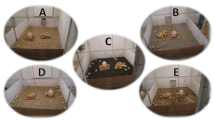The strength, balance, and mobility of central nervous processes, which determine behavior, were estimated in six-month-old pigs of the Large White breed. According to the proposed technique, tests with observation of the animal’s reactions to the care stuff, specificities of behavior in the course of feeding, responses to the unexpected sensory stimuli, and peculiarities of the formation of conditioned reflexes with estimation of the behavioral phenomena by a point scale allowed us to classify pigs as belonging to one of the four neurobehavioral types, strong balanced mobile (SBM), strong balanced inert (SBI), strong imbalanced (SI), and weak (W). Four groups of pigs of different above types (n = 5 in each) were formed. Their behavioral manifestations within 24-h-long observation periods were examined using a video monitoring system. It was found that pigs kept under stationary conditions (before stressing) spent most time (in different groups, 67.3 to 74.8% on average) in a static (resting) state, used 6.7 to 8.6% of time for feeding and drinking, and were in motion during 18.5 to 24.0% of time. Differences in the respective average indices shown by animals belonging to different neurobehavioral types were sufficiently clear, but in most cases did not reach the level of statistical significance. Technological stress (transfer to a summer camp and redistribution in groups) resulted in significant neurobehavioral type-dependent modifications of their behavior. At the beginning of the post-stress period, pigs of the SBM and SBI groups considerably decreased their motor activity, while in pigs of groups SI and W such activity was intensified. Immediately after stressing, feeding/drinking activity of pigs was strongly suppressed; in groups SBM, SI, and W such activity decreased two or even more times. Later on, clear trends toward return to the pre-stress values were observed in all behavioral indices (the respective dynamics noticeably depended on the neurobehavioral type). Some shifts, however, were observable even on the 30th post-stress day. The importance of taking into account the type of higher nervous activity under conditions of technologically advanced productive animal husbandry and of the selection work is discussed.
Similar content being viewed by others
References
The Ethology of Domestic Animals: an Introductory Text, P. Jensen (ed.), 3rd Edition, CABI (Sweden), 2017.
G. Vogt, “Stochastic developmental variation, an epigenetic source of phenotypic diversity with farreaching biological consequences,” J. Biosci., 40, No. 1, 159–204 (2015), doi: https://doi.org/10.1007/s12038-015-9506-8.
S. J. Hur, “A study on current risk assessments and guidelines on the use of food animal products derived from cloned animals,” Food Chem. Toxicol., 108, Pt. A, 85–92 (2017), doi: https://doi.org/10.1016/j.fct.2017.07.047.
P. Jensen, “Nest site choice and nest building of freeranging domestic pigs due to farrow,” Appl. Anim. Behav. Sci., 22, No. 1, 13–21 (1989), doi: https://doi.org/10.1016/0168-1591(89)90076-2
C. M. Clouard, B. Kemp, W. J. J. Gerrits, et al., “Impact of perinatal nutrition on spatial cognitive performance of pigs later in life,” in; Proc. 50th Congr. Internat. Soc. Appl. Ethol. July 12–15, 2016, Edinburgh, Wageningen Academic Publishers, 198 (2016).
I. J. M. M. Boumans, G. J. Hofstede, J. E. Bolhuis, et al., “Agent-based modelling in applied ethology: An exploratory case study of behavioural dynamics in tail biting in pigs,” Appl. Anim. Behav. Sci., 183, 10–18 (2016), doi: https://doi.org/10.1016/j.applanim.2016.07.011.
O. V. Danchuk, “Peroxidation of lipids and activity of the system of antioxidant protection in organisms of pigs with different types of higher nervous activity,” Thesis for the degree Doctor of Veterinary Medicine, Natl. Univ. of Life and Environ. Sci. of Ukraine, Kyiv, 2018.
P V. Karpovskii, R. V. Postoy, V. V. Karpovskii, et al., Patent for a useful model No. 95204, Ukraine, A61D 19/00, “A method of studying the conditioned reflex activity of pigs,” No. u201407747, claimed 10.07.2014, published 10.12.2014, Bull. No. № 12.
O. V. Danchuk, V. I. Karposvkii, V. A. Tomchuk, et al., “Temperament in cattle: a method of evaluation and main characteristics,” Neurophysiology, 52, 73–79 (2020).
V. V. Danchuk, O. V. Danchuk, T. I. Prystupa, et al., Evaluation of Motor Activity in Animals, Kam’yanets-Podil’skii, PDATU, 2015, 39 p.
E. Kanitz, T. Hameister, M. Tuchscherer, et al., “Social support attenuates the adverse consequences of social deprivation stress in domestic piglets,” Horm. Behav., 65, No. 3, 203–210 (2014), doi: https://doi.org/10.1016/j.yhbeh.2014.01.007.
L. Yang, Z. Zeng, and S. Wen, “A full-function Pavlov associative memory implementation with memristance changing circuit,” Neurocomputing, 272, 513–519 (2018), doi: https://doi.org/10.1016/j.neucom.2017.07.020.
F. J. Van der Staay, T. Schuurman, M. Hulst, et al., “Effects of chronic stress: A comparison between tethered and loose sows,” Physiol. Behav., 100, No. 2, 154–64 (2010), doi:https://doi.org/10.1016/j.physbeh.2010.02.020.
K. M. D. Rutherford, A. Piastowska-Ciesielska, R. D. Donald, et al., “Prenatal stress produces anxiety prone female offspring and impaired maternal behaviour in the domestic pig,” Physiol. Behav., 129, 255–264 (2014), doi: https://doi.org/10.1016/j.physbeh.2014.02.052.
M. Y. Zhang, X. Li, X. H. Zhang, et al., “Effects of confinement duration and parity on stereotypic behavioral and physiological responses of pregnant sows,” Physiol. Behav., 179, 369–376 (2017), doi: https://doi.org/10.1016/j.physbeh.2017.07.015.
Author information
Authors and Affiliations
Corresponding author
Rights and permissions
About this article
Cite this article
Danchuk, O.V., Broshkov, M.M., Karpovsky, V.I. et al. Types of Higher Nervous Activity in Pigs: Characteristics of Behavior and Effects of Technological Stress. Neurophysiology 52, 358–366 (2020). https://doi.org/10.1007/s11062-021-09892-7
Received:
Published:
Issue Date:
DOI: https://doi.org/10.1007/s11062-021-09892-7




